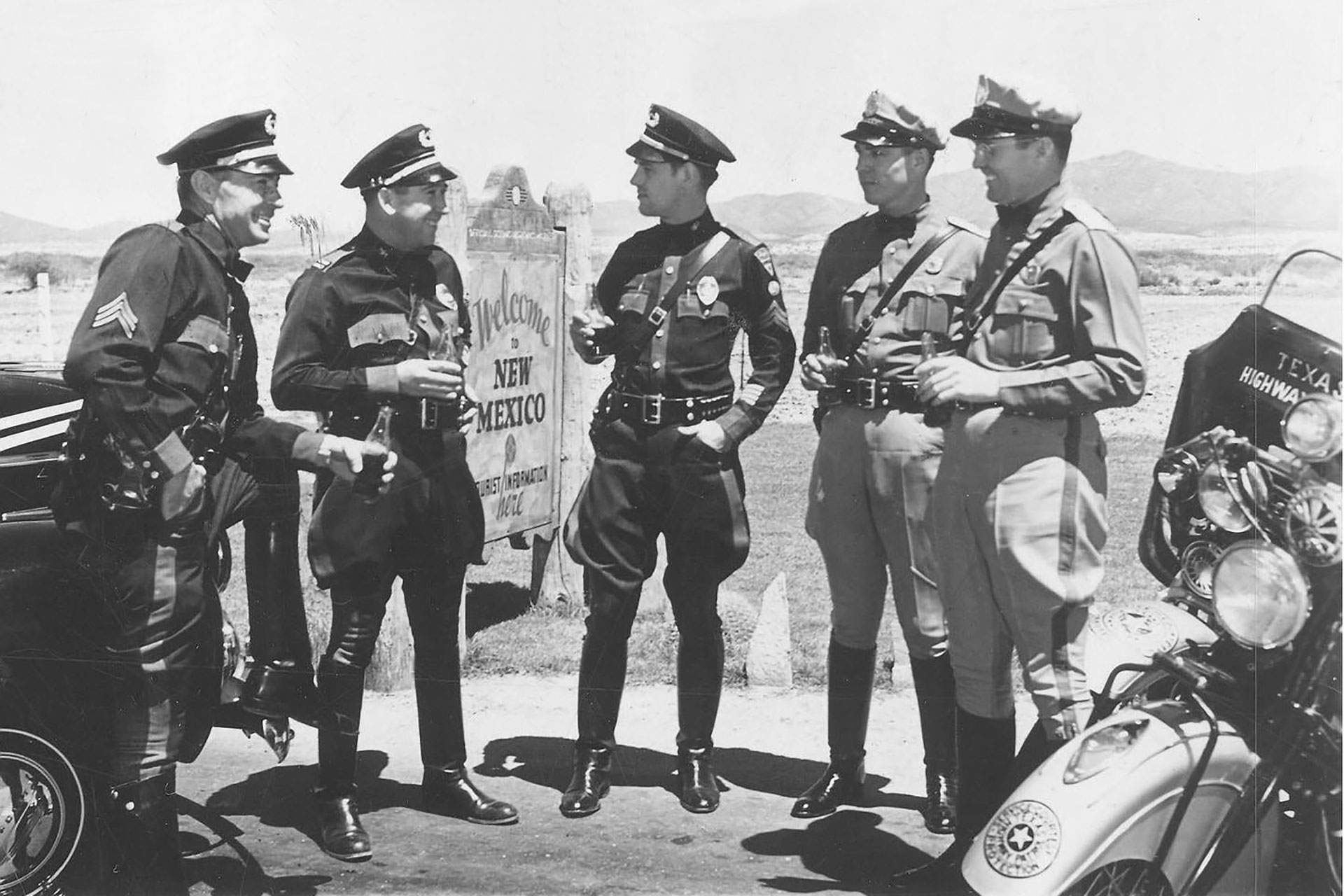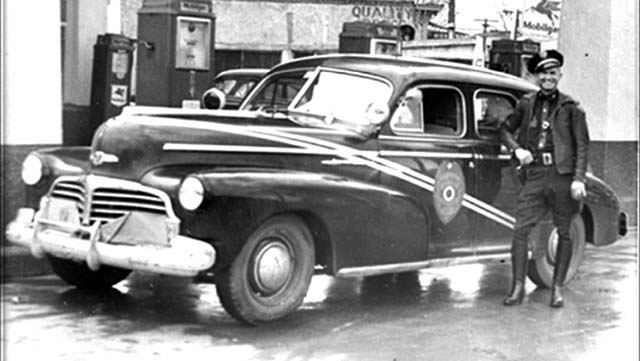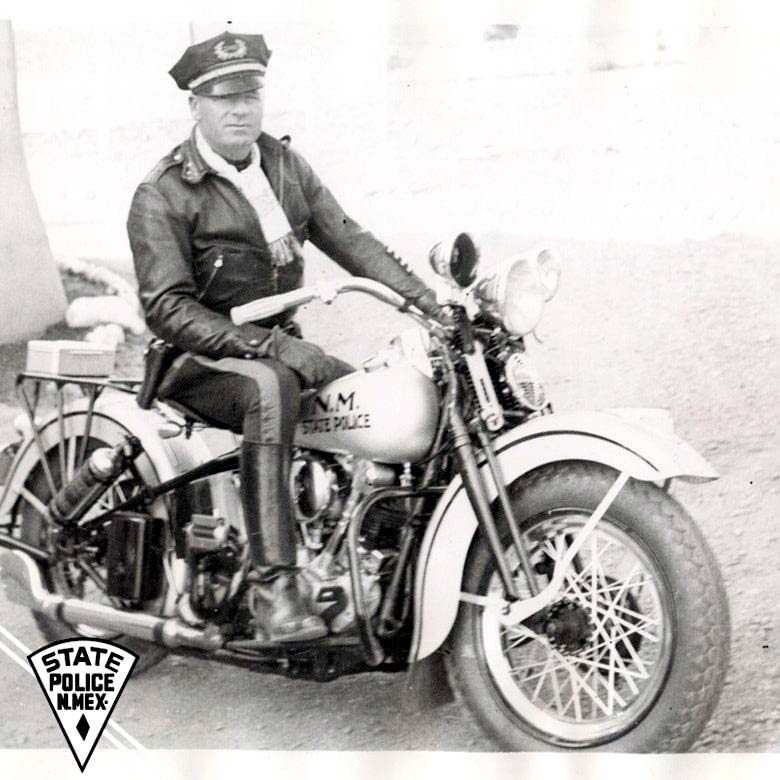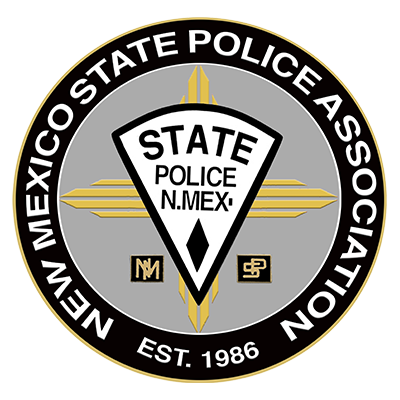 The original attempt at creating a New Mexico State Police Association was in 1972, after a group of State Police Officers met and begin plotting out the path. A meeting was held and officers were elected to serve on its Board. The first NMSPA Board members were Officer Ray Gallagher as the President, Officer George Chavez as the Vice President, Agent James Wilson as the Secretary, and Agent Abe Rodriquez as the Treasurer.
The original attempt at creating a New Mexico State Police Association was in 1972, after a group of State Police Officers met and begin plotting out the path. A meeting was held and officers were elected to serve on its Board. The first NMSPA Board members were Officer Ray Gallagher as the President, Officer George Chavez as the Vice President, Agent James Wilson as the Secretary, and Agent Abe Rodriquez as the Treasurer.
The purpose of creating the Association was to provide an effective and meaningful way in which the officers of the New Mexico State Police could present demands or suggestions to the New Mexico State Police Board and to the Chief of the New Mexico State Police. Officers of that day felt they were entitled to voice their concerns to their employer regarding such issues as hours of work, seniority assignments, and other matters pertaining to their terms and conditions of employment. This was an obvious attempt at becoming a union and being involved with collective bargaining. The Association joined the American Federation of State County Municipal Employees, an affiliate of AFL-CIO. A membership application was mailed to all State Police Officers.
On June 19, 1972, the officers of the Association Board, along with an attorney and other representatives, met with the New Mexico State Police Board and presented their request to form the Association, but the New Mexico State Police Board voted to not recognize the Association. As a further attempt at discouraging the creation of the Association, officers who were elected to the Board of the Association received transfers. This was felt by many to be an obvious attempt to discourage any further organized entities within the State Police Department. The department’s strategy worked, as the idea of an Association eventually faded away.
In 1983, Narcotics Sergeant Charlie Smith was involved in a narcotics raid that resulted in the death of the suspect. After the investigation, the local District Attorney filed homicide charges against Sergeant Smith. No system was available that would provide legal assistance to officers who were criminally charged while in the performance of their duties. The department covered officers in civil litigatons only. Narcotics Sergeant Jimmy Allison solicited donations from State Police employees that would assist Sergeant Smith with his legal fee. Sergeant Smith was subsequently acquitted.
This would be the start of the department’s Legal Fund. Sergeant Allison obtained permission from the State Police to allow members to contribute by means of payroll deduction to this Legal Fund. Sergeant Allison was assigned to oversee the Legal Fund and serve as President of the Board. In early 1984, Officer Russell Kirkpatrick and several other officers attempted to form an Association for the second time. A letter dated March 15, 1984, was sent to the Chief of the State Police requesting to meet with him and discuss the formation of the Association. The Chief refused to meet with the officers and, as before, officers involved were being transferred in another attempt to discourage the creation of an Association, which again prolonged the inevitable. In 1986, a bill was being introduced that would allow state employees the option of selling back unused sick leave that excluded State Police Officers. Discussions found their way into the cafeteria at the LEA Academy between Jimmy Allison and A.P. Wickard. A.P. Wickard handed Jimmy Allison $20, saying that would be the first donation toward a lawsuit against the Governor’s proposal. Jimmy Allison took it to heart and started collecting money from employees, including Chief Maurice Payne, which totaled $2,600. Without having to file the lawsuit, State Police Officers were included in the sick leave sell-back program. It was decided between A.P. Wickard and Jimmy Allison that the Chief should be approached with recommendations of using the collected money to start an Association.
With past experiences in mind, Jimmy Allison approached Chief Payne, who agreed to allow the creation of an Association. This Association would include all commissioned officers regardless of rank, as well as civilian personnel. It was decided to call the newly formed organization the New Mexico State Police Association.
 On March 24, 1986, Chief Payne directed employees to elect representatives to formulate the Association’s By-laws and Constitution. Each district would select one officer and one civilian. In the fall of 1986, the first Association Board was elected, to include the President, Vice President, Secretary/Treasurer, Officer Trustee, Civilian Trustee, and Retiree Trustee. The Board officers served two-year terms. Narcotics Agent Keith Bridges was elected as the first President of the Association. During his term, Governor Carruthers created the Department of Public Safety, which was strongly opposed by members of the Association. Being a newly formed organization, they had no voice in state government. Also during Keith Bridges’ term, the Roadrunner Magazine was created. As the Association’s official publication, it would boost the Association’s revenues.
On March 24, 1986, Chief Payne directed employees to elect representatives to formulate the Association’s By-laws and Constitution. Each district would select one officer and one civilian. In the fall of 1986, the first Association Board was elected, to include the President, Vice President, Secretary/Treasurer, Officer Trustee, Civilian Trustee, and Retiree Trustee. The Board officers served two-year terms. Narcotics Agent Keith Bridges was elected as the first President of the Association. During his term, Governor Carruthers created the Department of Public Safety, which was strongly opposed by members of the Association. Being a newly formed organization, they had no voice in state government. Also during Keith Bridges’ term, the Roadrunner Magazine was created. As the Association’s official publication, it would boost the Association’s revenues.
With Keith Bridges’ term completed, Sergeant Mike Bowen was elected as the Association’s second President. The department used Mike Bowen’s expertise as Legislative Liaison, which enabled him to meet many key members of the legislative body. Due to Mike Bowen’s influence, the State Police received a large salary increase. This was the Association’s first venture into the Legislative arena. The relationship between DPS and the Association was often strained, as DPS realized Mike Bowen had ushered in a new era for the New Mexico State Police Association.
DPS soon begin plans to transform SID Agents into State Police Agents through a lateral transfer program. This proposal called for changes in the State Police badges and shoulder patches to include the word DPS and separate the uniform division from the investigation division. Mike Bowen realized this opened the door to transforming the State Police into a highway patrol. The investigations division would be placed under the control of SID leadership, a non-State Police agency.
With support from legislators and the Governor, Mike Bowen successfully prevented this change. In 1991, Mike Bowen was promoted to Lieutenant and, in keeping with the Association’s By-laws, resigned as President.
Sergeant Ron Taylor was elected as the Association’s third President. Under Ron Taylor’s term, communication with the new administration was established as the Fair Labor Standards Act was imposed upon the department. The onset of FLSA ended the 50-year work schdule of the State Police, ending on-call time without compensation as well as the renowned “general hours.” Several members expressed their desire to file a lawsuit against DPS for monetary compensation for back on-call wages. The Association polled their membership, and the majority were not in favor of a lawsuit. During this time, general hours were eliminated and officers were placed on a 12-hour shift, working 8 and being on call the remaining 4. Several employees filed a lawsuit separate from the Association’s support, which subsequently forced the department to eliminate on-call time completely and place officers on three 8-hour shifts.
 Due to the shortage of personnel, one officer often covered several counties during a shift. The Association began working with the department to increase not only salary, but also personnel. Ron Taylor was assigned to a five-year planning conference. After Ron Taylor’s term was completed, Officer Fred Laird was elected as the fourth President of the Association. Fred Laird continued working in legislative issues until he resigned as President.
Due to the shortage of personnel, one officer often covered several counties during a shift. The Association began working with the department to increase not only salary, but also personnel. Ron Taylor was assigned to a five-year planning conference. After Ron Taylor’s term was completed, Officer Fred Laird was elected as the fourth President of the Association. Fred Laird continued working in legislative issues until he resigned as President.
Officer Tim Baughman was elected as the fifth President of the Association. During his term, the Association was involved in the expansion plans of the Law Enforcement Academy, as well as a salary increase for State Police. During this time, a new DPS administration was appointed and plans to merge SID into State Police once again arose. The new DPS administration begin plans to close several State Police Communication Centers around the state. This would result in loss of jobs. Discussions from DPS included merging all State Police Communication Centers into one or two centers, as well as contracting with local agencies. The Association began opposing DPS, which resulted in strained relationships. Tim Baughman was able to ward off the proposal to merge SID into State Police, but the closure of communication centers continued.
After Tim Baughman’s term was completed, Officer Norman Rhoades was elected as the sixth President of the Association. Norman Rhoades continued with opposition to closing communication centers. The Association realized any major opposition to DPS would mean representation by professionals, which would mean funds. The Association Board contracted with Civic Development Group to conduct residential fundraising campaigns. This drastically increased the Association’s budget. With the new budget, the Association contracted with attorney A.J. Olsen, a former State Police Officer, and lobbyist Mike Bowen, who had recently retired. These two men provided the Association with strategic avenues that eventually pressured DPS to abandon their plans of closing communication centers, but not before Farmington, Deming, and Clovis were closed and Raton was partially closed.
 The focus of DPS then turned once again toward merging SID, and now Motor Transportation Division (MTD), into State Police. A 30-day “gentleman’s academy” was proposed that would allow SID and MTD to become State Police Officers, keeping their current rank and status. During this time, the Association worked closely with Senator R.L. Stockard, a retired State Police Captain, other legislators, and the Chief’s Office, which resulted in the largest salary and personnel increase in the history of the State Police.
The focus of DPS then turned once again toward merging SID, and now Motor Transportation Division (MTD), into State Police. A 30-day “gentleman’s academy” was proposed that would allow SID and MTD to become State Police Officers, keeping their current rank and status. During this time, the Association worked closely with Senator R.L. Stockard, a retired State Police Captain, other legislators, and the Chief’s Office, which resulted in the largest salary and personnel increase in the history of the State Police.
Members of the Association became dissatisfied with the Cabinet Secretary, and a poll indicated the majority favored conducting a Vote of Confidence. This vote resulted in the majority of Association members indicating they had no confidence in the leadership ability of the Cabinet Secretary. This resulted in a unanimous vote by the Legislative Finance Committee to recommend the separation of State Police from DPS, a move strongly supported by the Association. The Cabinet Secretary subsequently resigned from DPS.
The second Cabinet Secretary was quick to pick up on the merge issue, which resulted in A.J. Olsen filing an injunctive order against the Governor, Attorney General, and DPS Cabinet Secretary through the Supreme Court. The Governor’s Office quickly responded, and an agreement was reached to withdraw the injunction and the merge issue would be dropped barring legislative action. The Cabinet Secretary wasted no time in introducing a bill that altered current statutes governing State Police. This Bill would have allowed the Cabinet Secretary the authority to bypass the State Police application process and allow SID and MTD the lateral option with rank. Mike Bowen and several State Police Officers met with Senator Michael Sanchez, who basically killed the bill.
The DPS Cabinet Secretary subsequently resigned, and a third Cabinet Secretary was appointed. This Cabinet Secretary was quick to pick up the merge issue and subsequently worked on a bill that would abolish State Police, transforming State Police Officers, SID, and MTD into DPS Officers to maintain their current rank, with changes in unit and uniform design. The Cabinet Secretary made it clear that he would see the abolishment of the Association. During this time, Norman Rhoades’ term was completed and Vice President Richard Anglada was elected as the seventh President of the Association. Bill Richardson was elected Governor and appointed retired State Police Chief John Denko as Cabinet Secretary and Carlos Maldonado as Chief. These appointments were highly supported by the Association. Secretary Denko and Chief Maldonado have long been in support of the Association and a working relationship was quickly established.
 The new administration quickly terminated any plans of merging into State Police. The Association begin initiatives to aggressively support salary and benefit packages for the State Police Officers and support staff. Richard Anglada was promoted to the rank of Lieutenant and, in compliance with the Association’s bylaws, resigned his position as Association President. The Board appointed Norman Rhoades to complete Richard Anglada’s term, which would be months. The Association enjoyed a working relationship with the administration for the first time in several years.
The new administration quickly terminated any plans of merging into State Police. The Association begin initiatives to aggressively support salary and benefit packages for the State Police Officers and support staff. Richard Anglada was promoted to the rank of Lieutenant and, in compliance with the Association’s bylaws, resigned his position as Association President. The Board appointed Norman Rhoades to complete Richard Anglada’s term, which would be months. The Association enjoyed a working relationship with the administration for the first time in several years.
The Roadrunner Magazine had been dormant, and it was decided to appoint Ron Taylor to the position of editor. With his professional approach and knowledge of State Police history, the Roadrunner Magazine reached new heights since its inception and continues to be a publication that enhances the image of all State Police Officers.
When Norman Rhoades’ term was once again completed, Jason Griego was elected as the ninth President of the Association. The Association continues working on behalf of the New Mexico State Police.
